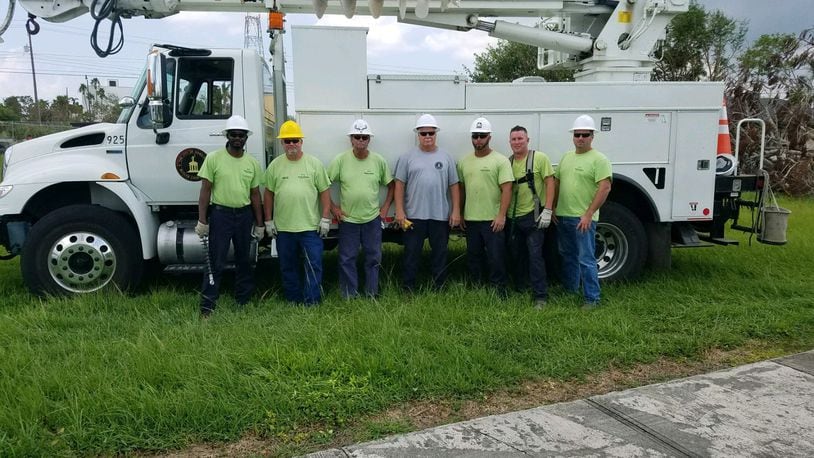“The drive down there was the worst part of the whole thing,” said Joe Schlichter, Hamilton’s assistant superintendent for electric distribution, who has worked for the city 10 years. “You got down to Florida, and I-75 was just backed up, people trying to get back into town.”
The first day’s travel to Troy, Ala., took 10 hours because the Hamilton trucks only get about about 175 miles per tank, so there was a lot of refueling, with maximum speeds of 6o mph. The next day, Homestead officials told the Hamilton crew not to drive into the storm, but to instead “stay back” until the storm passed.
“Once that cleared, we left the next morning, it was around 5 in the morning, and showed up in Homestead the next day around 4:30 in the morning,” Schlichter said. Typically, the entire trip would be expected to take 17½ hours, in normal vehicles.
“We took a 500-gallon fuel tank that we pulled behind us, and we actually ended up using that a few times, because the fuel stations were backed up,” he said. “People were trying to get off at gas stations, and there were lines as far as you could see, trying to get into the gas stations. Luckily, we bought a bunch of food to put in our trailer, so we stopped at a rest area, ate lunch, and then pretty much skipped supper, went on through.”
They took one bucket truck, a “digger truck” that digs holes for utility poles, and a pickup truck with a cargo trailer behind it.
“It was hotter than what I’m used to working in,” Schlichter said. The damage wasn’t “quite as bad as in the Keys and all that, but there was some destruction — roofs of houses, there were a few with shingles ripped off and all that.”
The first day, the pouring rain that soaked boots, followed by sweltering heat, was brutal, he said.
Many service wires in backyards were down, and street lights were left dangling from their poles. Some wires were ripped from homes that needed reattaching. And, “a lot of street lights were just kind of dangling,” he said.
One of their tasks involved replacing distribution wires in a 17-pole span where five of the 17 poles had snapped at the ground, cutting power to hundreds.
“That took us about two and a half days to replace it,” he said.
There also were broken poles in backyards and other areas the Hamilton crew repaired.
American Municipal Power of Ohio helped connect Homestead, Fla., officials with Hamilton and other Ohio cities.
Homestead residents and officials were thankful for the more than 160 additional people from across the country who helped, said Zachary Good, a public information officer for the city, including 20 from Ohio.
“It was a huge help,” because after the storm, all customers were without power, he said.
The Hamilton crew stayed comfortably at a Courtyard by Marriott, because securing rooms for the helpers had been one of Homestead’s priorities, and all meals were catered at the city’s utilities shop. That was much more comfortable than in 2005, when Schlichter helped after Hurricane Katrina, where for the first few nights, the hotel where they stayed had no power or showers, with two guys to a twin bed, and some people sleeping in tents. After Irma, some other contractors stayed in fairgrounds, sleeping in their trucks, he said.
“Just for Homestead, there were about, I would say, 20 other municipalities. One was from Canada. One was from Wisconsin,” Schlichter said. “They had a heck of a drive.”
The crew turned time cards in to Hamilton. Homestead is paying the city out of pocket, and will be reimbursed by the Federal Emergency Management Agency, Good said. Hamilton’s crew was paid regular time, plus time-and-a-half pay after regular time, under legislation approved by Hamilton City Council.
Even as recently as a week ago, the crew still was dragging from their long trip, Schlichter said.
But they were very proud on their journey home as they saw so many utility crews migrating back north on the interstate, “side by side, one in front of the other,” he said.
“I think that was a picture you can’t really describe,” he said.
“It’s very prideful,” he said. “You get the last person back on (the grid), and you know you’ve accomplished something….”
About the Author
